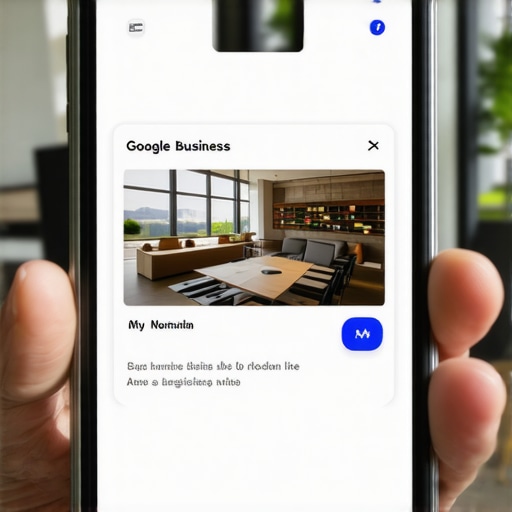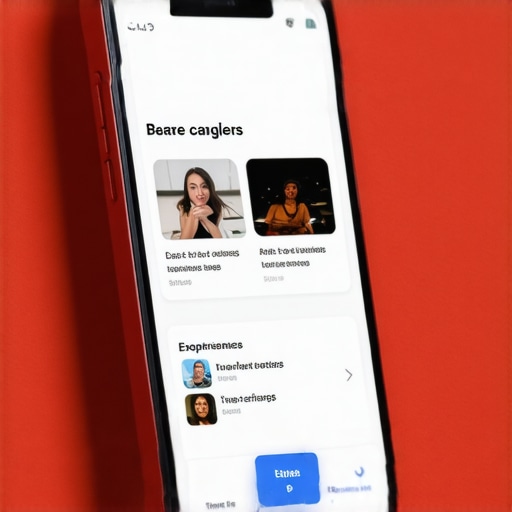Unlocking the Power of CTR Optimization for Rapid Google My Business Success
In the fiercely competitive landscape of local SEO, click-through rate (CTR) has emerged as a pivotal factor influencing Google My Business (GMB) rankings. As seasoned digital marketers recognize, leveraging advanced CTR strategies can significantly accelerate local visibility, especially when aligned with Google’s evolving algorithmic signals. This article explores the nuanced methods to harness CTR for rapid GMB ranking improvements, blending data-driven insights with tactical precision.
Deciphering the Complex Relationship Between CTR and Local SEO Algorithms
Google’s local ranking algorithm has grown increasingly sophisticated, factoring in diverse signals such as relevance, proximity, and prominence. However, the CTR serves as a vital behavioral indicator of user engagement, subtly signaling the quality and relevance of your GMB listing. According to recent studies, effective CTR signals can accelerate your position in local pack results, especially when combined with optimized listing elements.
Implementing Data-Driven CTR Tactics for Hyper-Localized Impact
Advanced strategies involve meticulous optimization of your GMB profile, including compelling titles, keyword-rich descriptions, and strategic use of local keywords. Additionally, employing A/B testing on call-to-action buttons and images can reveal high-converting elements that boost CTR. Leveraging Google Posts with engaging content and timely updates further nurtures user interest, leading to higher click rates. These tactics, underpinned by analytics, ensure your efforts are targeted and measurable.
How Can Local Business Owners Effectively Measure and Improve CTR in Real-Time?
What are the most reliable metrics and tools to monitor CTR performance and adapt strategies swiftly?
Google My Business Insights provides fundamental CTR data, but integrating third-party analytics platforms can offer deeper behavioral insights. Tools such as advanced CTR signal analysis enable real-time monitoring, allowing marketers to refine their tactics dynamically. Crucially, continuous testing of listing elements and user engagement signals ensures sustained improvement in local rankings.
For comprehensive mastery, consider consulting authoritative sources like the Google Search Central Blog, which offers ongoing updates on algorithmic shifts affecting local SEO strategies.
Engage with industry peers and share your insights on CTR optimization to stay ahead in this rapidly evolving domain. Your professional contributions can shape emerging standards and innovative tactics.
Explore more advanced techniques and case studies by visiting our Ultimate Guide to Fast GMB Ranking CTR Signals.
Harnessing Psychographic Data to Fine-Tune Your CTR Tactics
While traditional CTR optimization focuses on keywords and listing elements, integrating psychographic insights can elevate your strategy. Understanding your target audience’s motivations, preferences, and behaviors allows you to craft compelling call-to-actions and content that resonate deeply, prompting higher engagement. For instance, tailoring your Google Posts with messaging that appeals to local community values or emotional triggers can significantly increase click rates, especially when paired with precise keyword targeting. Dive into tools like Google Trends or customer surveys to gather these insights and refine your content accordingly. This nuanced approach not only boosts immediate CTR but also enhances overall user engagement, contributing to sustained local ranking improvements.
Challenging the CTR-Only Paradigm: Are Other Signals Equally Critical?
While boosting CTR is undeniably powerful, experts argue that focusing solely on click metrics may overlook other vital signals. Engagement behaviors such as call clicks, direction requests, and messaging interactions also serve as behavioral indicators that Google considers for ranking. According to industry authority Moz, a comprehensive local SEO approach combines CTR with these secondary signals to create a more holistic optimization strategy. Therefore, while optimizing for CTR, businesses should also optimize for ease of contact and interactions, ensuring their listings facilitate direct engagement. This multi-faceted tactic ensures that your GMB profile aligns with Google’s complex ranking algorithms, which are increasingly sophisticated and data-driven.
Are there innovative tools or frameworks that help unify CTR and engagement signals for superior local SEO results?
Yes, emerging platforms like BrightLocal and SEMrush have integrated advanced analytics that consolidate various user engagement metrics, including CTR, call clicks, and messaging interactions. These tools enable marketers to develop comprehensive dashboards, allowing real-time performance tracking and strategic adjustments. Moreover, adopting a framework such as the “Engagement Optimization Cycle”—which systematically tests, analyzes, and refines listing elements—can lead to continuous improvements. For detailed tactics and case studies, visit our Ultimate Guide to Fast GMB Ranking CTR Signals for actionable insights and proven strategies.
Leveraging Behavioral Signals Beyond CTR for Holistic Local SEO Success
While optimizing CTR is a cornerstone of rapid GMB ranking improvements, forward-thinking marketers recognize the importance of integrating multiple behavioral signals to craft a comprehensive local SEO strategy. For instance, actions such as direct messaging, website visits, and phone calls serve as powerful indicators of genuine user intent and engagement. According to a detailed analysis by Moz, combining CTR with these secondary interactions can significantly amplify your local visibility and authority, especially when aligned with your overall digital presence.
Implementing Sophisticated A/B Testing Frameworks to Maximize CTR and Engagement
Advanced local SEO practitioners employ systematic A/B testing frameworks that go beyond simple element swaps. These frameworks involve iterative testing of listing titles, descriptions, images, and call-to-actions, coupled with multivariate analysis to identify combinations that yield the highest engagement metrics. Using tools like SEMrush or BrightLocal, you can track the interplay between different signals, allowing for data-driven refinements that optimize your entire user journey—from search query to conversion. This expertise-driven approach ensures your GMB profile evolves dynamically, maintaining a competitive edge in local search results.
What is the Impact of User Experience (UX) Design on CTR and Local Engagement Metrics?
How do elements such as page load speed, mobile responsiveness, and visual hierarchy influence user behavior and search rankings?
UX design profoundly impacts user engagement behaviors, including CTR. A seamless, fast-loading mobile experience reduces bounce rates and encourages clicks, while well-organized visual hierarchies guide user attention towards key actions like calls or directions. Google’s algorithms increasingly prioritize user satisfaction metrics, which are directly influenced by UX factors. A study by Google’s Search Central emphasizes that mobile-first design and rapid page speeds are critical for improving not only user experience but also local search rankings, highlighting the importance of integrating UX optimization into your CTR enhancement strategies.

Illustration of a mobile-optimized GMB listing with clear call-to-action buttons and high-loading speed indicators, emphasizing user experience impact on CTR.
Advanced Tools and Frameworks for Unified Signal Optimization
Emerging platforms like LocalFalcon and Whitespark have begun to offer unified dashboards that consolidate CTR, call clicks, messaging, and website interaction metrics. These tools enable marketers to visualize the full spectrum of user engagement, identify bottlenecks, and implement targeted improvements. Adopting frameworks such as the “Engagement Signal Optimization Cycle”—which emphasizes continuous testing, analysis, and refinement—can systematize your efforts, resulting in sustained local ranking advancements. For expert-level insights and case studies, explore our comprehensive resource: Ultimate Guide to Fast GMB Ranking CTR Signals.
Harnessing Advanced Behavioral Analytics for Enhanced Local Visibility
In the realm of localized SEO, understanding and leveraging behavioral analytics beyond conventional CTR metrics can unlock unprecedented growth. Integrating tools such as heatmaps, session recordings, and sophisticated attribution models enables marketers to decipher nuanced user interactions, revealing hidden opportunities for optimization. For instance, analyzing how users navigate your GMB listing and which elements attract prolonged engagement can inform targeted improvements that elevate your CTR and overall ranking. According to industry research by HubSpot, the integration of these advanced analytics significantly enhances decision-making precision, leading to more effective local SEO strategies.
What Role Does Voice Search Optimization Play in CTR Enhancement?
As voice search continues its meteoric rise, optimizing your GMB profile for voice queries becomes essential. Voice-activated searches often involve conversational keywords and localized intent, which can influence CTR differently than traditional text searches. Incorporating natural language keywords, FAQs, and conversational content tailored for voice search can increase your listing’s visibility in voice results, thereby boosting CTR and engagement. Moz’s recent whitepaper highlights that voice search optimization can improve local pack prominence, making it a vital component of a holistic CTR strategy.

Illustration of a voice search interface displaying local business information, emphasizing the importance of voice optimization for CTR growth.
How Can AI-Powered Personalization Elevate Your Local SEO Efforts?
Implementing AI-driven personalization within your GMB strategy allows for dynamically tailored content and call-to-actions based on user behavior, demographics, and search intent. Machine learning algorithms can predict the most compelling messaging for different audience segments, increasing the likelihood of clicks. For example, personalized offers or localized messages delivered via Google Posts and messaging features can significantly enhance engagement. As per Gartner’s research, businesses utilizing AI personalization see an average CTR increase of up to 30%, underscoring its transformative potential in local SEO.
Are There Emerging Techniques to Integrate Multichannel Engagement Metrics for Superior Results?
Yes, leveraging multichannel engagement tracking—combining data from social media, review sites, and direct website traffic—provides a comprehensive view of user intent and behavior. Platforms like SEMrush and BrightLocal now offer unified dashboards that synthesize these signals, facilitating a holistic approach to CTR optimization. Employing frameworks such as the “Integrated Engagement Model” enables marketers to adapt strategies dynamically, ensuring that every touchpoint contributes to improved local rankings. For example, aligning review responses and social media interactions with your GMB updates can synergistically enhance user trust and CTR, as supported by findings from Search Engine Journal.
What Are the Critical UX Design Principles That Can Drive Higher CTR in Local Listings?
How do mobile responsiveness, visual hierarchy, and intuitive navigation influence user engagement and search rankings?
Exceptional UX design fundamentally sustains user attention and encourages interaction. Mobile responsiveness ensures seamless access across devices, reducing bounce rates and increasing the likelihood of CTR. Visual hierarchy guides users toward primary actions, with strategic placement of contact buttons, reviews, and directions. Additionally, intuitive navigation within your GMB profile and linked website fosters trust and facilitates conversions. Google’s algorithm increasingly prioritizes user satisfaction metrics; thus, adopting UX best practices is not only beneficial for engagement but also vital for maintaining a competitive edge in local rankings.
Expert Insights & Advanced Considerations
1. Integrate Multichannel Engagement for Holistic SEO
Combining signals from social media, reviews, and direct interactions creates a comprehensive view of user behavior, enabling more precise CTR optimization and ranking improvements.
2. Leverage Psychographic Data for Targeted Content
Understanding your audience’s motivations and preferences allows for crafting compelling, personalized content that significantly boosts CTR and local visibility.
3. Prioritize User Experience (UX) Design
Optimizing page load speed, mobile responsiveness, and visual hierarchy directly influences user engagement metrics and search rankings, making UX a critical component of advanced CTR strategies.
4. Utilize AI-Powered Personalization
Implementing AI-driven content customization enhances relevance and engagement, leading to higher CTR and improved local ranking outcomes.
5. Embrace Continuous A/B Testing Frameworks
Systematic testing of listing elements and user pathways allows for data-driven refinements, ensuring sustained improvements in CTR and overall SEO performance.
Curated Expert Resources
- Google Search Central Blog: Offers authoritative updates on algorithm changes and SEO best practices, essential for staying ahead in local SEO.
- BrightLocal: Provides advanced analytics and dashboards that consolidate engagement metrics, facilitating comprehensive performance tracking.
- SEMrush: Features tools for multichannel analytics and competitive benchmarking, vital for strategic CTR optimization.
- HubSpot: Shares insights on behavioral analytics and personalization techniques, enhancing understanding of user engagement beyond basic metrics.
Final Expert Perspective
Mastering the art of rapid Google My Business ranking through CTR strategies requires a sophisticated, multi-layered approach. Integrating multichannel signals, leveraging psychographic insights, and continuously testing your tactics ensures your local SEO efforts remain agile and effective. As the landscape evolves, expert-level practitioners stay informed by authoritative sources like the Google Search Central Blog and utilize advanced analytics platforms for data-driven decisions. Embrace these insights and resources to elevate your local business visibility and sustain a competitive edge in search rankings. For those committed to excellence, ongoing professional engagement and strategic refinement are the keys to long-term success. Dive deeper into these strategies, share your insights, and keep pushing the boundaries of what’s possible with CTR optimization in local SEO.

